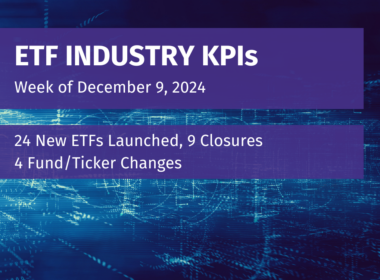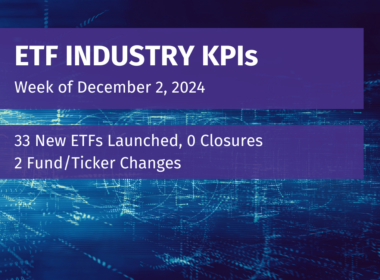Direct indexing has been getting a lot of attention these days, and the conversation is not really just about the benefits of direct indexing – it’s often about how it will replace ETF investing.
There’s a common narrative about Direct Indexing that centers on ETF industry disruption and displacement. It’s often a story about innovation that surpasses what the ETF wrapper offers. How? By allowing investors to own the securities that comprise an index directly – rather than owning shares of an ETF tracking that index. The key benefits of this approach include portfolio customization and tax loss harvesting at the individual security level.
This week, if you look at the agenda for the Schwab Impact conference, there are half a dozen panels dedicated to Direct Indexing in just two days. It’s as if the case for Direct Indexing isn’t just being told, it’s being told in bold, all-caps font. And Schwab – like many billing Direct Indexing as the cool new kid on the block – has skin in the ETF game. They are the fifth largest ETF issuer with almost $250 billion in ETF assets.
Some of the headlines around Direct Indexing vs. ETFs been truly awesome. Smart Asset’s recent article said: “So Long, ETFs. Direct Indexing Is All The Rage.” Just last week, Forbes had this one: “Fintech Startup Atomic Has A Plan For Blowing Up The $8 Trillion ETF Industry.” In it, the CEO of this fintech, David Dindi, didn’t measure words: “We believe that ETFs will be dead in the next five years.”
Blow up. Dead. So long, ETFs.
I can’t honestly figure out why such hyperbolic storytelling in this space.
Direct indexing, in itself, isn’t especially new. Separately Managed Accounts (SMAs) have been direct indexing, literally, for investors looking for customization and better tax management beyond what mutual funds could deliver since the 1970s.
What’s new here is the technology powering it, enabling implementation of direct indexing across platforms reaching a much broader audience.
Historically, SMAs have been typically the realm of high net worth individuals because transaction costs could quickly mount when you are implementing highly customized portfolios designed around complex goals and objectives. But commission-free trading has helped change that, along with fintech innovation that is making customization not only doable but scalable. Schwab, Fidelity, Vanguard, Blackrock – you name it – just about everyone has a direct indexing solution they either developed or acquired these days.
There’s no argument that technological innovation is cool. Being able to own exactly what you want at a price you can afford is living the dream. ETFs themselves were built on that dream: democratizing access at the lowest possible cost. And they continue to innovate on both fronts – access and fees – looking to improve investor outcomes.
So, why are we, as an industry, talking about Direct Indexing in a doom and gloom context for ETFs?
I searched for some wisdom from the frontlines by asking advisors and strategists what they thought. Is Direct Indexing revolutionizing the way we invest? Are clients asking for it?
Here’s some of what they had to say:
- It’s great marketing, but there are underappreciated risks.
“Direct Indexing is just lipstick on a pig — an overly diversified SMA account which is not an innovation of the industry, but instead just a new marketing angle for an old product that takes advantage of the Vanguard Boglehead movement.”
“One idea that is commonly sold along with this is Tax Loss Harvesting, which has its merits, but if overdone, can lock people into low basis portfolios that might create more job security for the advisor than value to their client.”
“Fees are too opaque, still, in Direct Indexing and leave room for fees to be added in future.”
“[Direct indexing] adds a lot of cumbersome work for the advisor that could likely be better used towards other efforts to add value to the client’s situation.”
- It’s a great tool for DIY investors, but complexity matters.
“Direct Indexing is a new use of technology that offers additional tools for individual investors. For those who like to manage their own portfolios, the true ‘do it yourselfers,’ DI can be an excellent tool that can make customized portfolio management easier. That said, we don’t really see DI as a threat to ETFs as both DI and ETFs have their own unique benefits. Creating portfolios using ETFs can involve fewer holdings and greater simplification, and as many studies have shown, individual stock selection plays only a minor part in portfolio performance over time. More important are asset allocation, country, and industry selection.”
“From a risk and return perspective, DI may offer limited value and unnecessary complexity.”
“Depending on the individual’s situation, DI may offer additional benefits over ETFs like the ability to realize losses on individual stocks. However, since the vast majority of individual investor stock market exposure is held in tax-sheltered accounts, such as IRAs and 401(k)s, that too may limit DI appeal compared to ETFs.”
- It can distract you from your long-term goals.
“Some pros [of direct indexing] are more control over taxes and the opportunity for customization. Some cons: Direct indexing can be more expensive than passive investing. It may also cause clients to lose focus of their long-term financial goals and encourage more frequent trading.”
Direct Indexing a Threat to ETFs?
Put simply, according to one advisor we talked to: “DI can be an excellent tool for those who wish to dedicate the resources to use the technology most effectively, but will likely not be an existential threat to the ETF industry.”
Another one was a little more blunt: “Not a threat to ETFs at all, period.”
Perhaps the challenge with making sense of disruptive innovation is the disruptive part – how do you assess what the future holds for an existing business/industry when a new way of accessing or doing something emerges?
If certainty or conviction are impossible, and we are transacting in opinions only, it’s that much harder to get behind some of the doomsday narrative around this Direct Indexing vs. ETFs debate. Many providers say it’s the future. Many allocators say “not so fast.” Who’s right?
I came across some comments from a few years back from Prof. Clayton Christensen, who’s an expert on innovation and its impact on business growth, talking about this idea of disruption to existing business models. He leads a course called “Disruptive Strategy” at Harvard Business School, and he says this about disruptive innovation:
“Almost always disruption is an opportunity long before it’s a threat.”
According to him, disruption can trigger or motivate existing businesses to innovate or to create “whole new markets” in a process that can happen long before that industry or business is at risk of losing its customer base and/or dying.
If you think of SMAs vs. mutual funds, they have coexisted for about 50 years thus far. If we think about mutual funds vs ETFs, we are looking at 30 years of stories and headlines calling for the end of one in light of the other.
That logic suggests that disruptive innovation doesn’t necessarily lead to the death of the predecessor, or to its blowing up into oblivion. It could actually fuel reinvention, or trigger new solutions within an existing business.
It does, however, suggest that no business or industry can ever rest on its laurels. Disruption demands action.
“It’s important to start innovating now while the core is strong,” Prof. Christensen says of businesses faced with disruption. “Never does the core technology just collapses over a weekend and the new one takes over instantaneously. [But] you’ve got to start on the new before the old gets sick.”
Disclosure
All investments involve risk, including possible loss of principal.
This material is provided for informational purposes only and should not be considered an individualized recommendation or personalized investment advice. The investment strategies mentioned may not be suitable for everyone. Each investor needs to review an investment strategy for his or her own particular situation before making any investment decision.
All expressions of opinion are subject to change without notice in reaction to shifting market conditions. Data contained herein from third party providers is obtained from what are considered reliable sources. However, its accuracy, completeness or reliability cannot be guaranteed.
Examples provided are for illustrative purposes only and not intended to be reflective of results you can expect to achieve.
The value of investments and the income from them can go down as well as up and investors may not get back the amounts originally invested, and can be affected by changes in interest rates, in exchange rates, general market conditions, political, social and economic developments and other variable factors. Investment involves risks including but not limited to, possible delays in payments and loss of income or capital. Neither Toroso nor any of its affiliates guarantees any rate of return or the return of capital invested. This commentary material is available for informational purposes only and nothing herein constitutes an offer to sell or a solicitation of an offer to buy any security and nothing herein should be construed as such. All investment strategies and investments involve risk of loss, including the possible loss of all amounts invested, and nothing herein should be construed as a guarantee of any specific outcome or profit. While we have gathered the information presented herein from sources that we believe to be reliable, we cannot guarantee the accuracy or completeness of the information presented and the information presented should not be relied upon as such. Any opinions expressed herein are our opinions and are current only as of the date of distribution, and are subject to change without notice. We disclaim any obligation to provide revised opinions in the event of changed circumstances.
The information in this material is confidential and proprietary and may not be used other than by the intended user. Neither Toroso or its affiliates or any of their officers or employees of Toroso accepts any liability whatsoever for any loss arising from any use of this material or its contents. This material may not be reproduced, distributed or published without prior written permission from Toroso. Distribution of this material may be restricted in certain jurisdictions. Any persons coming into possession of this material should seek advice for details of and observe such restrictions (if any).












